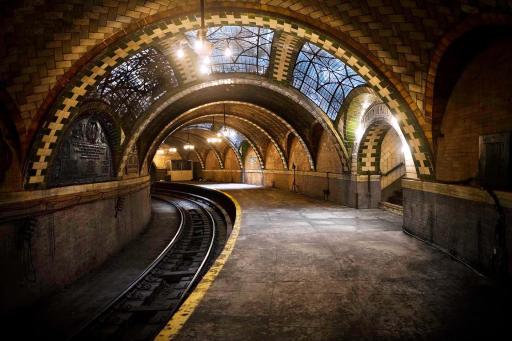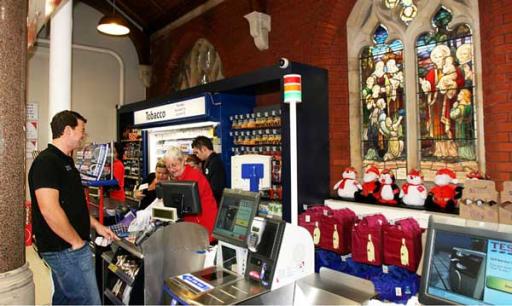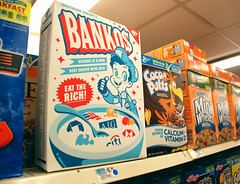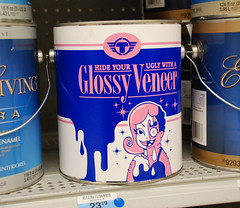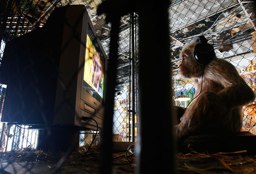The Null Device
Posts matching tags 'nyc'
2012/9/1
New York is facing an onslaught of middle-aged subway taggers; latchkey kids from the 1970s and 1980s who never put graffiti vandalism behind them, or else who decided to recapture their lost youth, spurred on by one thing or another to pick up their spraycans and get back into the game:
In torn jeans and saddled with a black backpack, Andrew Witten glances up and down the street for police. The 51-year-old then whips out a black marker scribbles "Zephyr" on a wall covered with movie posters. He admires his work for a few seconds before his tattooed arms reach for his daughter, holding her hand as he briskly walks away.
Witten's brush with fame now often comes with his freelance art writing and his sporadic visits to his daughter's school, where he teaches her classmates how to draw. Lulu knows her father draws "crazy art," a term she picked up from seeing graffiti on trains.
For decades, Ortiz, 45, has been known on Manhattan's Lower East Side as LA II. A traumatic loss of a girlfriend brought him out of a 14-year hiatus from graffiti writing. He has since been caught three times spraying his tag on property, each time while walking a friend's dog. "Everywhere that dog stopped to pee I would write my name," Ortiz says. "The streets were like my canvases. I just started writing my name everywhere."Alternatively, it could be argued that he and his dog bonded by participating in territory-marking activities together.
2011/3/7
Another milestone in the sterilisation of New York: the Chelsea Hotel, a long-term residence of many artists (some of whom paid their rent in artworks), including the likes of Leonard Cohen, Patti Smith and Robert Mapplethorpe, and epicentre of the old bohemian New York which has almost entirely vanished, is up for sale. The hotel's veteran former owner, Stanley Bard, is holding out hope that the new buyer will keep the hotel as is, allowing its bohemian residents to stay, though it looks more likely that it'll be transformed into another Chateau Marmont-style luxury theme hotel, trading off its name.
But among possible buyers mentioned is Andre Balazs, who owns the trendy Standard Hotel chain and the luxury Chateau Marmont in Hollywood. There are rumors that developer extraordinaire Donald Trump has shown interest. Future owners may dream of cashing in on the Chelsea name, while transforming the quirky set-up into something more resembling a straightforward hotel.
2010/11/13
2010/8/27
In New York, Catholics are planning a rally to protest against the Empire State Building's owners refusal to light up the building to commemorate Mother Teresa. The Catholic League for Civil and Religious Rights are outraged that the building owners turned down their request to light the upper floors in blue and white to honour the nun's 100th birthday, especially since they did light the same floors in red and yellow for the 60th anniversary of the founding of the (Godless, Communist) People's Republic of China. The building's owners, meanwhile, reiterate a long-standing policy of not accommodating requests by religions or for religious figures. The rally is expected to shut down 34th Street at rush hour.
(In the interest of context: Christopher Hitchens' exposé of Mother Teresa and her works.)
2010/8/24
Some culture-jammers in New York have affixed official-looking "Spoiler Alert" signs to LED train attival signs in the subway.
Their rationale is that the recently installed signs erode faith in the system, create false hopes, erase the "mystery and magic" of the Subway and "threaten historical social behaviors, rendering obsolete the time-honored New York tradition of leaning over the platform edge with the hope of glimpsing headlights from an approaching train".
2010/4/14
The latest frontier of Antipodean coffee culture: New York, where Melbourne-style cafés, and even a barista college, are opening:
''The New York coffee scene is similar to Melbourne in 1985. When I moved here about six years ago, there was virtually nowhere that served quality espresso coffee. I originally planned to pick up an idea here and then move back to Melbourne to cash in. But I realised there was a huge opportunity here because nothing in New York compared to our cafes,'' Mr Hall says.Though wasn't Melbourne's coffee scene at a fairly decent technical level, if not yet acclaimed around the world, in 1985? After all, Australia had mass Italian immigration in the 1950s, resulting in the establishment of Italian-style cafés catering to patrons who expected quality. (This is not to be confused with places where handfuls of immigrants trickled in and opened cafeterias or diners, making whatever the locals were already used to; this is the case in the UK, where there are plenty of cafeterias run by Italian immigrants, most of them serving the greasy fry-ups and mugs of builder's tea the locals feel comfortable with. It seems to me that a country only assimilates a culinary tradition if it takes in enough migrants from that tradition to not only act as producers but also as discerning consumers.)
2010/4/13
New York Magazine has an interesting piece on tensions between hipsters and hasidim in Williamsburg, which began when hipsters started moving to the staunchly Orthodox Jewish neighbourhood of Brooklyn in the 1990s and came to a head with a dispute over a bike lane which, the hasidim complained, funnelled a steady stream of immodestly-clad nonbelievers through the core of their devoutly observant community:
But after a while, says one Hasidic real-estate developer, “People started talking to the rabbis—‘Hey, something’s happening, all these young white people are moving in.’ ” When the Satmars realized that the Artisten—the Yiddish name they used for the bewildering newcomers—were there to stay, something like panic set in. Rabbis exhorted landlords not to rent to the Artisten, builders not to build for them. One flyer asked God to “please remove from upon us the plague of the artists, so that we shall not drown in evil waters, and so that they shall not come to our residence to ruin it.’’ Rabbi Zalman Leib Fulop announced that the Artisten were “a bitter decree from Heaven,” a biblical trial.While there is an element of conservative-old-timers-vs.-offensive-newcomers to the story, it is (as most things are) more complex than that. Most of the property rented out to the artisten was done so by Hasidic owners, who have mostly kept the hipsters out of the core of their community. Meanwhile, there is more interplay between the ultra-conservative community and the newcomers, with some fence-sitters putting a foot in both camps:
For South Williamsburg’s Hasids, Traif Bike Gesheft functions as a semi-secret window onto the larger world and a clubhouse of mild transgressions. Herzfeld rents bikes to Hasids at no cost, just to get them to venture beyond the neighborhood. (Among Satmars, bicycles are not specifically disallowed but are considered taboo nonetheless.) Inside the shop, otherwise righteous men let down their guard. Tongues loosen. “The men, they don’t know how to have a conversation with a woman,” Herzfeld explains, talking a mile a minute. “Whenever they come to the bike shop, the first thing they ask me to find them a prostitute. I tell them, look, you’re searching for answers. You’re not going to find them in the vagina of a woman you’re paying $200 an hour. If you want to meet somebody, you need to step outside of the community, you need to get a hobby. Come over, and I’ll teach you how to fix a bike. So the bike shop is a kind of outreach program.” A friend of Herzfeld’s also uses the shop to slip Hasids traif books like The Catcher in the Rye and The Great Gatsby.
If hipster Williamsburg has a social architect, it is Schwartz. His first project, in 1999, became the mini-mall that redefined Bedford Avenue. The retail collection he developed was both a parody of the American mall and a startling improvement on it. It housed an artisanal-cheese shop, a wine store, a bookseller with Guy Debord window displays, a Tibetan tchotchke store, a vinyl-heavy indie-record emporium, a Mac-friendly computer shop, and, of course, a coffeehouse. Many of these businesses later grew to take up their own storefronts on what became the hipster side of Bedford. Schwartz followed it up with Opera House Lofts, another ambitious development targeted squarely at the Artisten. His latest and largest project—Castle Braid, a 144-unit complex so named after the factory in A Tree Grows in Brooklyn—is borderline hipster pandering. The game room has foosball and air hockey. On my arrival, the PA system in the lobby was softly playing Beck’s “Nobody’s Fault But My Own.” The building holds its own film festival (the first prize is six rent-free months) and a tenant-compiled library with Erotica and Gay-and-Lesbian sections. “It is totally kosher,” explains Schwartz, a devout Hasid. “I’ve been joking that I do this to make sure the Artisten stay on the other side!”
2010/4/3
A New York-based group of culture jammers calling themselves TrustoCorp has been droplifting parodic products into supermarkets:
2008/11/26
New York Magazine has an interesting piece on cities, living alone and the myth of endemic urban loneliness and alienation:
Of all 3,141 counties in the United States, New York County is the unrivaled leader in single-individual households, at 50.6 percent. More than three-quarters of the people in them are below the age of 65. Fifty-seven percent are female. In Brooklyn, the overall number is considerably lower, at 29.5 percent, and Queens is 26.1. But on the whole, in New York City, one in three homes contains a single dweller, just one lone man or woman who flips on the coffeemaker in the morning and switches off the lights at night.
These numbers should tell an unambiguous story. They should confirm the common belief about our city, which is that New York is an isolating, coldhearted sort of place. Mark Twain called it “a splendid desert—a domed and steepled solitude, where the stranger is lonely in the midst of a million of his race.” (This from a man who settled in Hartford, Connecticut.) In J. D. Salinger’s 1952 short story “De Daumier-Smith’s Blue Period,” the main character observes that wishing to be alone “is the one New York prayer that rarely gets lost or delayed in channels, and in no time at all, everything I touched turned to solid loneliness.” Modern movies and art are filled with lonesome New York characters, some so familiar they’ve become their own shorthand: Travis Bickle (in Taxi Driver, calling himself “God’s lonely man”); the forlorn patrons in Nighthawks (inspired, Edward Hopper said, “by a restaurant on New York’s Greenwich Avenue”); Ratso Rizzo (“I gotta get outta here, gotta get outta here,” he kept muttering in Midnight Cowboy … and died before he could).There are several assumptions here: the equation of living alone (outside of a stable nuclear family) with loneliness and psychological toll is one of them. Another one is the great American myth about small-town values, one we see trotted out (often by people on the right of culture-war politics) time and time again.
In American lore, the small town is the archetypal community, a state of grace from which city dwellers have fallen (thus capitulating to all sorts of political ills like, say, socialism). Even among die-hard New Yorkers, those who could hardly imagine a life anywhere else, you’ll find people who secretly harbor nostalgia for the small village they’ve never known.One problem with "small-town values" is that the word is often a dog whistle for a certain brand of reactionary intolerance; a strong in-group-vs.-out-group distinction, knee-jerk traditionalism, bigotry and petty authoritarianism, only painted in folksy Thomas Kincaid colours. One example of this that came around not so long ago was failed US vice-presidential candidate Sarah Palin approvingly quoting a fascist newspaper columnist's praise of "small-town America". If small towns stand as a symbol of intolerance and conformism, all things urban could be said to represent the opposite, cosmopolitanism and liberalism.
Cities, in other words, are the ultimate expression of our humanity, the ultimate habitat in which to be ourselves (which may explain why half the planet’s population currently lives in them). And in their present American incarnations—safe, family-friendly, pulsing with life on the street—they’re working at their optimum peak. In Cacioppo’s data, today’s city dwellers consistently rate as less lonely than their country cousins. “There’s a new sense of community in cities, an increase in social capital, an increase in trust,” he says. “It all leads to less alienation.”
Cacioppo and Patrick cite a range of studies showing that students in classes with the best rapport imitate each other’s body language; same goes for athletes on winning teams. The presence of other human beings puts a natural limit on how freakily we can behave. And where better to find them than in cities, where we have more ties? (Think about the sociopathic kids who shot other kids in Red Lake, Minnesota; at Northern Illinois University; at Virginia Tech—what do they have in common? They were living in isolated places.) Robert Sampson, paraphrasing Durkheim, puts it this way: “The tie itself provides health benefits. That’s where I started with my work on crime.”
In any case, recent research has revealed that the equation of living alone and loneliness does not follow; for one, what sociologists call "weak ties" are at least as important to psychological wellbeing as more intimate connections, and cities full of singletons are swarming with potential weak ties (and often stronger ones as well):
“In our data,” adds Lisa Berkman, the Harvard epidemiologist who discovered the importance of social networks to heart patients, “friends substitute perfectly well for family.” This finding is important. It may be true that marriage prolongs life. But so, in Berkman’s view, does friendship—and considering how important friendship is to New Yorkers (home of Friends, after all), where so many of us live on our own, this finding is blissfully reassuring. In fact, Berkman has consistently found that living alone poses no health risk, whether she’s looking at 20,000 gas and electricity workers in France or a random sample of almost 7,000 men and women in Alameda, California, so long as her subjects have intimate ties of some kind as well as a variety of weaker ones. Those who are married but don’t have any civic ties or close friends or relatives, for instance, face greater health risks than those who live alone but have lots of friends and regularly volunteer at the local soup kitchen. “Any one connection doesn’t really protect you,” she says. “You need relationships that provide love and intimacy and you need relationships that help you feel like you’re participating in society in some way.”
In fact, many Internet and city behaviors we consider antisocial have social consequences. Think of people who lug their laptops into public settings. In 2004, Hampton and his colleagues looked at just those people—at Starbucks, in fact, in Seattle and Boston—and concluded that a full third of them were basically using their laptops and interacting at the same time. (Cafés, in other words, were like dog runs, and laptops were like pugs, encouraging interaction among solitaries.) Hampton did a similar study of laptop users in Bryant Park, and the same proportion, or one-third, reported meeting someone they hadn’t before. Fifteen percent of them kept in touch with that person over time (meaning that about 5 percent made lasting ties out of a trip to Bryant Park with a laptop).
Conversely, married people—women especially—have smaller friendship-based social networks than they did as single people, according to Claude Fischer. In a recent phone conversation with the sociologist, I mentioned a related curiosity I came across in a paper about the elderly and social isolation in New York City: The neighborhoods where people were at the greatest risk, it seemed, were in neighborhoods where people seemed very married—family neighborhoods, in fact, like Borough Park and Ridgewood. “That’s not strange at all,” he says. “They’re the prime category of people to be isolated.” He explains that these people “aged in place,” as sociologists like to say, staying in the homes where they raised their own families. Then their spouses died, and so did their cohort (or it moved to a retirement community), and they’re suddenly surrounded by strange families, often of different classes or ethnic backgrounds, with whom they’re likely to have far less in common. “Unless they have children living nearby,” he says, “they’re likely to be quite isolated.”The article concludes with the notion that the internet—another thing often pooh-poohed as alienating and antisocial—functions, in terms of facilitating weak ties, much like a city; in fact, like the ultimate city:
Think about it: Serendipitous encounters between people who know each other well, sort of well, and not at all. People of every type, and with every type of agenda, trying to meet up with others who share that same agenda. An environment that’s alive at all hours, populated by all types, and is, most of the time, pretty safe. What he was saying, really, was that New York had become the Web. Or perhaps more, even: that New York was the Web before the Web was the Web, characterized by the same free-flowing interaction, 24/7 rhythms, subgroups, and demimondes.
(via Mind Hacks) ¶ 0
2008/10/9
Banksy's latest art project, unveiled in New York, is a step away from "street art" and culture jamming and into the territory of conceptual art: he seems to have taken a leaf out of Pascal Bernier's book, and opened a fake pet shop full of grotesque animatronic food-animals, such as walking chicken nuggets.
He added that there was a serious, philosophical aspect to the work, saying: "I wanted to make art that questioned our relationship with animals and the ethics and sustainability of factory farming but it ended up as chicken nuggets singing."
Banksy defended the pet show exhibition even though it contained no graffiti by saying: "If it's art and you can see it from the street, I guess it could still be considered street art."There's more about it here.
2007/11/4
A new study has discovered the phenomenon of suicide tourism, which involves people committing suicide choosing to do so at or near iconic landmarks or historic locations, and travelling to do so. The study claims that one in every 10 suicides in Manhattan is by an out-of-towner who travelled to the city expressly to die:
Some 274 suicides by non-residents were recorded in Manhattan between 1990 and 2004, more than half of them as a result of long falls from bridges and high-rise commercial buildings, including hotels, according to the report.I once read that luxury hotels are a big suicide magnet, with many treating themselves to a luxurious exit, though this is the first time I heard of suicide tourism as such (not counting specific examples, such as various bridges).
